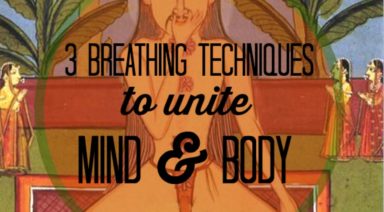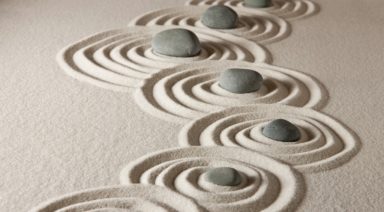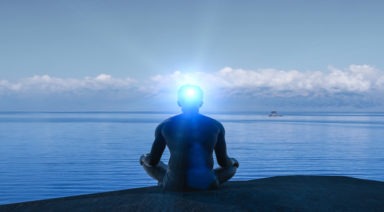Soham: Wisdom You Can Access

I first learned to meditate over 40 years ago. Friends of mine learned Transcendental Meditation in high school, but I couldn’t afford the fee. I had friends in college who also learned the TM method, but again, I was unable to pay and no one was parting with any information about the process. Stubbornly, I took it upon myself to research meditation techniques in the library and learned as much as I could. This was my introduction to mantras. I chose a mantra and one beautiful day, sitting under a tree, I gave it a whirl. It changed my life.
Your first mediation is never forgotten.
Eventually, I learned the TM method from a certified teacher. Although the basic idea was the same, I was given my mantra and in my first experience, felt a great opening of consciousness that I hadn’t experienced before. It was different. With this in mind, I began experimenting with mantras. One day, I meditated with the Soham mantra, not knowing what to expect. I found it to be peaceful, relaxing and connective in a way that’s hard to explain.
One With the Universe
Soham is Sanskrit and essentially means, “He whom I am.” It could be translated as, “I am He,” implying, “I am one with everything,” The “He” in this case is the Universe and the singularity of the divine. Soham is an ancient mantra and one that has been used in different ways, by numerous groups and societies. Some believe that it can connect us to what are known as, “The Ascended Masters.”
A Human Tendency to Expand and Interpret
The term “Ascended Masters” was coined in the 1930s and used to define spiritual adepts whom, after their time on Earth, ascend to a place where they help guide humanity and commune, or merge, with those who seek their wisdom. This movement gained great popularity and had a vast following, one that still exists today. This wasn’t the first time such an idea had been put forth. Theosophy, through Madame Blavatsky, had “The Great White Brotherhood.”
Many have accused Blavatsky’s work as being discriminatory, or outright racist. Some have pointed to her writings as being instrumental in helping to design theories for the Nazi party. It’s hard to know the actual truth behind all of this, but I genuinely don’t believe that Blavatsky had any such thoughts about singling out one race, or type of people, as being “less” than others. I’m certainly not an expert on Theosophical philosophy, but I’ve read some of her works and can see both sides of the argument. The complexity of her writing style is open to a myriad of different interpretations, as is often the case with any spiritually based text.
This brings me to a point. One of the things that human beings tend to do, is take a basic thought and then expand upon it, often to fulfill our own philosophical ideals and agendas. A quick look at history should convince us of the power of this process.
Through rhetoric and dogma, it’s often possible to reinterpret the underlying purpose of a text, in order to rationalize our unique point of view.
This has been done again and again in religion and is also a powerful tool in politics, where interpretations of founding documents are hotly contested and reviewed. Perhaps this is one of the dangers of proclaiming a text to be sacred. They may, in fact, be sacred, but the interpretation of these texts and ideas are usually man-made. Some seek to overcome this ambiguity through an individual, a human channeling a specific source, one pure and spiritually unquestionable. Enter the Ascended Masters, or so say those who believe in the doctrine.
I’m wary of most spiritual systems. It’s not my desire to demean, nor cast doubt upon, any religion or philosophy. I’m a metaphysician and have been a seeker for most of my life, so I’m used to being left out, considered odd, deemed ignorant, thought simpleminded, or daft. I’ve experienced way too much not to believe, but I’ve also seen enough to realize that there has to be a standard of feasibility that allows us not to be deluded, or worse.
This amorphous, subjective realm exists somewhere between hard fact and faith.
It’s for this reason that I’ll discuss the Ascended Master concept a bit differently than some might. I’ve known individuals who consulted with an Ascended Master, through a channel, and received advice, only to have another channel of the exact same Master contradict the advice earlier given. It always amazes me that the seeker is able to rationalize the discrepancy, through some excuse or the other. It speaks to the unreliability of the process at the very least, and to much bigger problems, at worst.
Ascended Masters: A Conceptual Offering
I believe that anything can be mined for its positive, beneficial value and doesn’t have to be presented in a specific form to be of use. This doesn’t imply that the Ascended Master belief isn’t valid, or is unworthy of study. I’ve known many who have been followers of its doctrine and received value in their lives, some through personal work and others through relying on a Master being channeled. It simply isn’t my way of doing things.
To be direct, it seems overly religious and even though the Masters are purported to be from various cultures and eras, it strikes me as being a form of Saint worship. As I said, there’s nothing wrong with that; it just isn’t my thing, but it still has value. With that in mind, let’s look at what it can offer you.
We Are Never Alone
A common thread throughout spiritual cultures is a belief in a place to where our consciousness can ascend to and there share information and commune with fellow members, past, present and future. These locations have different names, appearances and purposes, but they all share one goal, to help those in need, or who seek truth. By this doctrine, we are never alone.
I do believe that there is an intelligence that seeks to guide us, one that is powerful and ancient.
I consider this intelligence to be the accumulated knowledge and wisdom of all humanity, from the beginning to the present. I don’t see a need to identify specific members of our species in this, as that quickly turns into a form of worship and defeats the purpose. This could be considered a form of ancestral guidance, since it depends upon people who have passed, their only agenda to better their progeny, namely us. Incidentally, I consider our time on this planet to be just as important and to have the same goal.
If we’re not doing something to better the human experience, then we’re missing the point of being human.
How then can we find this place and connect? The ability to receive this information, this wealth of humanity, is not only possible, but within your grasp. It takes concentration, determination, sincerity and the ability to listen to truth without fear, or prejudice. I believe that this has been one of the motives behind much of the ritual that we have been obsessed with over the millennia. Luckily, connecting is much simpler than it sounds and one method of doing so is the use of mantras, one of them being Soham.
I mentioned earlier that I’ve used different mantras over the years and can attest to the fact that each mantra has a definitive and unique energy. Some of these mantras have had influences that I was able to discern, while others are still a mystery to me. Each sound in Sanskrit has a specific energy and combining different sounds can be like putting together commands on a computer, accessing more information than seems possible.
The Soham Mantra: The Oneness of All
The Soham mantra, by the very nature of its meaning, “I am He whom I am,” indicates an association with the divine monad, the oneness of all.
As one meditates upon this word, it becomes a personal appeal, from us to the Universe, to unite with everything. By extension, we are then connected to the wisdom of all and can gain an inner understanding of ourselves, perhaps otherwise inaccessible to the conscious mind. This is something that you can do and benefit from.
Practice: Soham Meditation
As with anything, there are different opinions as to how the Soham mantra should be used. I find it to be aligned with natural breathing. When I inhale, I think, “So.” When I exhale, I think, “Ham.” There are masters who contradict this, insisting that Ham is the inhale and So the exhale. There are just as many masters who disagree with them. Many practitioners vocalize their mantras aloud. I prefer silent mantra repetition and personally feel silence to be more powerful, but in truth, it’s completely up to you.
A simple way of using the Soham meditation is to sit in a relaxed way that connects you to your process. For me, it’s a comfortable chair; for others it may be a yoga position. Do what you feel connects you to your source. Close your eyes, or leave them open if you prefer, and begin reciting the mantra, either out loud or to yourself, and forget about a goal. Breathe in, “So.” Breathe out, “Ham.” Let the words resonate in your mind, but don’t overthink it. Be in the moment and allow yourself to be devoid of motive or purpose of thought, other than to be.
Your mind will race, but never scold it. Instead, smile and return to the mantra.
I never ask for information or wisdom directly, but you may do so if you choose. I open my mind to whatever may come. Sometimes it takes a few minutes, other times information is there quickly. I have meditations where nothing comes through at all, except a deep and profound sense of calm and the conviction that something much more powerful than me is present. That’s good enough for me. Once again, determination, patience and sincerity will eventually deliver results, often spectacularly.
The information is out there and is designed to be accessed by every one of us, not just channels who speak for Ascended Masters. There is nothing supernatural about any of this. In fact, I believe that this is an important part of Humanity. It seeks to guide us in the way that will make us better than we are and can help to pave the way for the future. It reasserts our ethics and redefines our values in an ever-changing world.
I consider it to be a link in the chain of the spiritual evolution of our species and I pray that we will always listen. Tap into the source and listen to the voice. Everyone will benefit. Never forget, it begins with us.
I wish you all peace and love.
How to Create a Meditation Altar

In The Miracle of Mindfulness, Zen Master Thich Nhat Hanh says that we should meditate because “each of us needs to realize total rest…mindfulness is the miracle by which we master and restore ourselves.” Sometimes, even a full night’s sleep doesn’t help you achieve total rest. How can the restless truly rest in modern society? Mindfulness, or the art of living in the present moment, is an important state of being to achieve in such a busy world. It’s not only good for your overall well-being, but it’s also an excellent way to practice self-love. Discover how to make a meditation altar designed for your specific spiritual practice.
1. Develop a Daily Meditation Practice
As we rush through life, many of us feel like we’re not quite present in every moment. According to Karen Kissel Wegela, Ph.D., to counter this feeling, practice mindfulness meditation. Meditation allows you to let go when stressed and accept yourself just as you are – your thoughts, feelings, and emotions as they arise from moment to moment.
It is important to have a meditation practice that grounds and centers you daily. Such a practice will allow you to feel strongly connected to and centered with yourself. Sometimes, breathing exercises aren’t enough. You need a physical place to go to and rest. While mindfulness meditation can be practiced anywhere, having a sacred space to call your own is important. An altar is a beautiful space full of sacred energy that you can tap into when you need it. Anyone can create an inspirational altar with just a few items and pure intention.
















